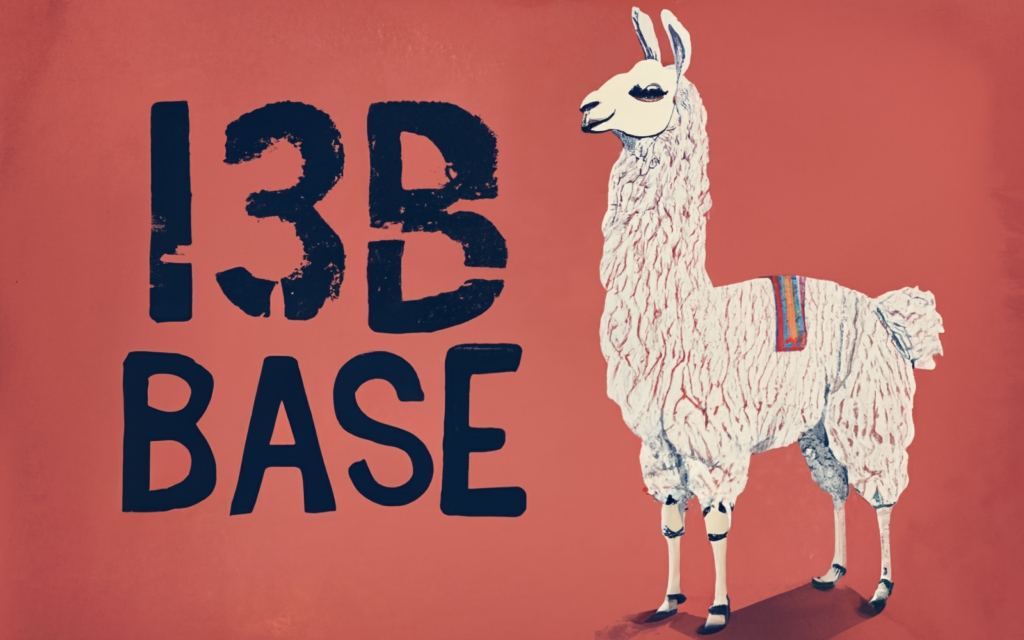llama-2-13b
Maintainer: meta

193

| Property | Value |
|---|---|
| Run this model | Run on Replicate |
| API spec | View on Replicate |
| Github link | View on Github |
| Paper link | View on Arxiv |
Create account to get full access
Model overview
The llama-2-13b is a base version of the Llama 2 language model from Meta, containing 13 billion parameters. It is part of a family of Llama models that also includes the llama-2-7b, llama-2-70b, and llama-2-13b-chat models, each with different parameter sizes and specializations.
Model inputs and outputs
The llama-2-13b model takes in a text prompt as input and generates new text in response. The model can be used for a variety of natural language tasks, such as text generation, question answering, and language translation.
Inputs
- Prompt: The text prompt that the model will use to generate new text.
Outputs
- Generated Text: The text generated by the model in response to the input prompt.
Capabilities
The llama-2-13b model is capable of generating coherent and contextually relevant text on a wide range of topics. It can be used for tasks like creative writing, summarization, and even code generation. However, like other language models, it may sometimes produce biased or factually incorrect outputs.
What can I use it for?
The llama-2-13b model could be used in a variety of applications, such as chatbots, content creation tools, or language learning applications. Its versatility and strong performance make it a useful tool for developers and researchers working on natural language processing projects.
Things to try
Some interesting things to try with the llama-2-13b model include:
- Experimenting with different prompts and prompt engineering techniques to see how the model responds.
- Evaluating the model's performance on specific tasks, such as summarization or question answering, to understand its strengths and limitations.
- Exploring the model's ability to generate coherent and creative text across a range of genres and topics.
This summary was produced with help from an AI and may contain inaccuracies - check out the links to read the original source documents!
Related Models

llama-2-70b

341
llama-2-70b is a base version of the Llama 2 language model, a 70 billion parameter model created by Meta. It is part of a family of Llama 2 models that also includes the llama-2-7b and llama-2-7b-chat models. The Llama 3 model family, which includes the meta-llama-3-70b and meta-llama-3-8b models, are the newer generation of large language models from Meta. Model inputs and outputs llama-2-70b is a language model that can generate human-like text based on a given prompt. It takes a text prompt as input and produces a continuation of that prompt as output. Inputs Prompt**: The text prompt that the model will use to generate a continuation. Max new tokens**: The maximum number of new tokens the model should generate. Min new tokens**: The minimum number of new tokens the model should generate. Temperature**: A value that controls the randomness of the output, with higher values producing more random and diverse output. Top k**: The number of most likely tokens the model should consider when generating output. Top p**: The cumulative probability threshold the model should use when considering tokens to include in the output. Stop sequences**: A comma-separated list of sequences that should cause the generation to stop. Outputs Generated text**: The continuation of the input prompt, generated by the model. Capabilities llama-2-70b is a large language model that can be used for a variety of text generation tasks, such as creative writing, conversational responses, and summarization. Its large size and strong performance make it a capable model for many natural language processing applications. What can I use it for? You can use llama-2-70b for a variety of text generation tasks, such as: Creative writing: Generate fictional stories, poems, or other creative content. Conversational responses: Use the model to generate natural-sounding responses in a dialogue. Summarization: Condense long passages of text into concise summaries. Content generation: Create articles, blog posts, or other written content. The model's size and capabilities make it a powerful tool for a wide range of language-based applications. As with any large language model, it's important to carefully consider the ethical implications and potential misuses of the technology. Things to try Some interesting things to try with llama-2-70b include: Experiment with different prompts and settings to see how the model's output changes. Use the model to generate creative ideas or story plots that you can then develop further. Explore the model's ability to summarize long passages of text or generate concise responses to open-ended questions. Investigate how the model's output varies when you change the temperature, top k, or top p settings. Remember to use the model responsibly and consider the potential ethical implications of your experiments.
Updated Invalid Date

llama-2-7b

643
The llama-2-7b is a 7 billion parameter language model developed by Meta, the base version of their Llama 2 model series. It is a smaller variant of the larger meta-llama-3-70b and meta-llama-3-8b models, offering a more compact yet capable language understanding and generation system. The llama-2-7b can be further fine-tuned for specific tasks, as seen in the codellama-70b-instruct, codellama-7b, and codellama-7b-instruct variants, which are optimized for coding and conversational tasks. Model inputs and outputs The llama-2-7b model accepts a text prompt as input and generates a sequence of text as output. The key input parameters include the prompt, temperature (to control randomness), top-p (to control diversity), and max/min tokens to generate. The output is a list of generated text tokens. Inputs Prompt**: The input text prompt to generate from Temperature**: Adjusts the randomness of the output, with higher values being more random Top P**: Samples from the top percentage of most likely tokens during generation Max New Tokens**: The maximum number of tokens to generate Min New Tokens**: The minimum number of tokens to generate (or -1 to disable) Stop Sequences**: A comma-separated list of sequences to stop generation at Outputs Generated Text**: A list of generated text tokens Capabilities The llama-2-7b model has a wide range of natural language understanding and generation capabilities, making it useful for tasks such as text summarization, language translation, question answering, and more. It can be used to generate coherent and contextually relevant text, while also exhibiting some degree of reasoning and logic. What can I use it for? The llama-2-7b model can be used for a variety of applications, including content creation, chatbots, language modeling, and even code generation when fine-tuned. For example, you could use it to generate creative writing, product descriptions, or social media posts. It could also be integrated into customer service chatbots or virtual assistants to provide more natural and engaging interactions. Things to try One interesting aspect of the llama-2-7b model is its ability to adapt to different styles and tones of writing. You could experiment with providing prompts in different voices, such as formal, casual, or even playful, and observe how the model responds. Additionally, you could try providing prompts with specific constraints, such as a certain length or topic, to see how the model handles those challenges.
Updated Invalid Date

llama-2-13b-chat

4.7K
llama-2-13b-chat is a 13 billion parameter language model from Meta, fine-tuned for chat completions. It is part of the larger LLaMA family of models developed by Meta. Similar models in the LLaMA lineup include the llama-2-7b-chat, a 7 billion parameter chat-focused model, and the larger llama-2-70b with 70 billion parameters. Model inputs and outputs llama-2-13b-chat takes in a text prompt and generates a response. The model is optimized for conversational interactions, so the prompts and outputs tend to be more natural language oriented compared to some other large language models. Inputs Prompt**: The text prompt to be completed by the model. System Prompt**: An optional system prompt that helps guide the model's behavior. Parameters**: Various decoding parameters like temperature, top-k, and top-p that control the randomness and quality of the generated text. Outputs Generated Text**: The text generated by the model in response to the input prompt. Capabilities llama-2-13b-chat can engage in open-ended dialogue, answer questions, and generate human-like text on a variety of topics. It performs well on tasks like summarization, translation, and creative writing. The model's conversational abilities make it well-suited for chatbot and virtual assistant applications. What can I use it for? With its strong language understanding and generation capabilities, llama-2-13b-chat can be used for a wide range of applications, from customer service chatbots to creative writing assistants. Companies could potentially integrate the model into their products and services to enhance user experiences through more natural and engaging interactions. Things to try Try providing the model with prompts that encourage it to take on different personas or perspectives. See how its responses change when you give it a specific goal or task to accomplish. Experiment with various decoding parameters to find the right balance of creativity and coherence for your use case.
Updated Invalid Date

meta-llama-3-70b-instruct

117.2K
meta-llama-3-70b-instruct is a 70 billion parameter language model from Meta that has been fine-tuned for chat completions. It is part of Meta's Llama series of language models, which also includes the meta-llama-3-8b-instruct, codellama-70b-instruct, meta-llama-3-70b, codellama-13b-instruct, and codellama-7b-instruct models. Model inputs and outputs meta-llama-3-70b-instruct is a text-based model, taking in a prompt as input and generating text as output. The model has been specifically fine-tuned for chat completions, meaning it is well-suited for engaging in open-ended dialogue and responding to prompts in a conversational manner. Inputs Prompt**: The text that is provided as input to the model, which it will use to generate a response. Outputs Generated text**: The text that the model outputs in response to the input prompt. Capabilities meta-llama-3-70b-instruct can engage in a wide range of conversational tasks, from open-ended discussion to task-oriented dialog. It has been trained on a vast amount of text data, allowing it to draw upon a deep knowledge base to provide informative and coherent responses. The model can also generate creative and imaginative text, making it well-suited for applications such as story writing and idea generation. What can I use it for? With its strong conversational abilities, meta-llama-3-70b-instruct can be used for a variety of applications, such as building chatbots, virtual assistants, and interactive educational tools. Businesses could leverage the model to provide customer service, while writers and content creators could use it to generate new ideas and narrative content. Researchers may also find the model useful for exploring topics in natural language processing and exploring the capabilities of large language models. Things to try One interesting aspect of meta-llama-3-70b-instruct is its ability to engage in multi-turn dialogues and maintain context over the course of a conversation. You could try prompting the model with an initial query and then continuing the dialog, observing how it builds upon the previous context. Another interesting experiment would be to provide the model with prompts that require reasoning or problem-solving, and see how it responds.
Updated Invalid Date